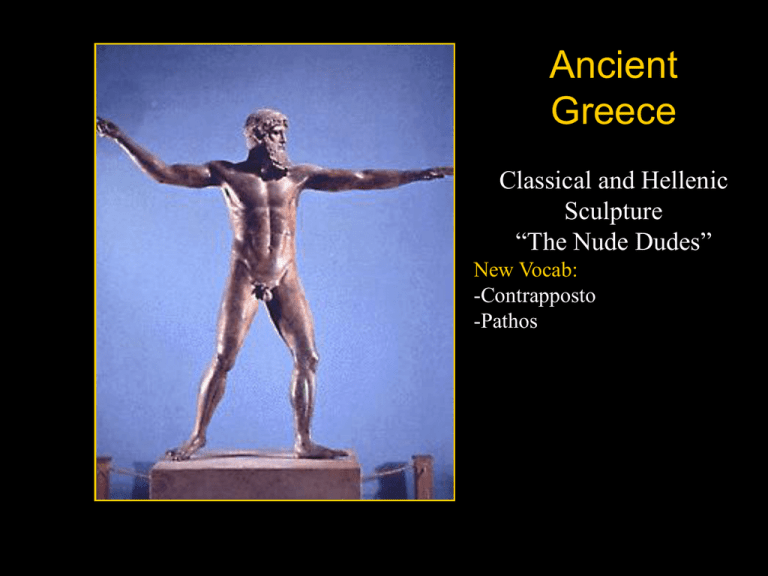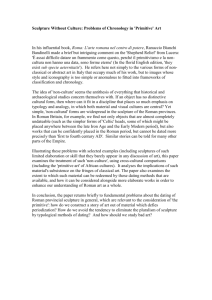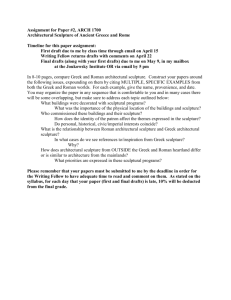greece3
advertisement

Ancient Greece Classical and Hellenic Sculpture “The Nude Dudes” New Vocab: -Contrapposto -Pathos Recovered from ruins of the Acropolis-differs significantly from earlier Kourousstands in a realistic way- with weight shifts-no more symmetry- faint s-curve Contrapposto- standing at ease, a balanced non-symmetry •Leg that carries the weight is the engaged leg, the other is the free leg •Major discovery- learning how to show the body at rest •Gives a new animation to the body-archaic smile is no longer needed- expressions are now more serious •Each muscle shows the new balance of weight in the Spear Bearer- even the head •The measure of true human beauty Spear Bearer (Roman Copy) 450-440 BC by Polyclitus The Severe Style•Started with the introduction of Contrapposto •describes sculpture between 480 and 450 BC •Charioteer- 1st large scale Greek bronze sculpture- contrapposto is present despite heavy clothing •Left foot is the engaged one •Folds of clothing are much softer than archaic sculpture- reflect the behavior of real clothshows the pull of gravity •Animated expression, very solemn Charioteer, 470 BC Pair of pediment sculptures are a good example of the severe style •Sculpture is active, but does not physically participate in action •Body has a tension, faces have emotion Apollo, Hippodamia, West pediment, Temple of Zeus at Olympia, c.460 BC Movement in statues-•Could only be achieved after the invention of contrapposto •Large, free-standing sculptures in motion is the greatest achievement of the severe style •Poseidon- in the act of throwing trident (or thunderbolt) •Pose is athletic, a gesture rather than in mid action- a divine action Poseidon (Zeus?) c.460-450 BC, Bronze - condenses a sequence of motions into a single pose- much more complex •Brings in era of the mature classical style •All sculpture was effected by new freedom Discobolus, Roman marble copy of Greek bronze c. 450 BC by Myron •Carved as a pediment sculpture •Tells the story of Niobid who bragged about her children to Apollo and Artemis- the Gods killed her children and shot an arrow in her back •The drapery serves as a dramatic device- shows the violence in her pose •Purpose was to show a beautiful female body in strenuous action •Unites suffering and motion Dying Niobid, c.450-440 BC Pathos- suffering conveyed with nobility and restraint- meant to touch us rather than horrify us Compare Parthenon Sculptures Dionysus, East pediment of Parthenon, c. 438-432 BC Ease of movement, poetry- fit into the pediment, but stands alone Three Goddesses, east pediment, 438-432 Also fits into pediment, drapery adds to ease and spaciousness of the sculpture Architectural sculpture is clearly moving away from the confines of the pediment Characterized by great sense of rhythm Horsemen, west frieze of Parthenon c. 440 BC Phidian StylePhidian was the chief overseer of artistic enterprises sponsored bu Pericles- Parthenon sculpture fits under this category, but many different artisans worked on them Why is she taking off her shoes??? •Rhythm and grace in an awkward position •Figure is strongly detached from background •Garment makes her look wet Nike, balustrade of Temple of Athena Nike, 410-407 BC Painting also reflected the Phidian style •Three-dimensional •Shapes exist in depth •Uses foreshortening •Most classical painting examples have been lost The “Achilles Painter”, 440-430 BC Pre-Hellenic, 4th Century Sculpture--400-100 BC •The period after the Peloponnesian War and before the rise of Alexander the Great From Mausoleum at Halicarnassus, funerary monument • structure probably derived from Egyptian idea- very “un-Greek” •Scopas- recognizable style •Of the Parthenon tradition, but the physical violence depicted is very unClassical Scopas, Battle of the Greeks and Amazons, east frieze Mausoleum, 359-351 BC •Drapery has its own volume •Intense gaze •Probably done by Praxiteles or was influenced by- focused on feminine grace Demeter from Cnidus, 340-330 BC •1st completely nude figure of Aphrodite •Statue became a synonym for absolute beauty Cnidian Aphrodite (Roman copy) 300 BC Done by Praxiteles •Sense of complete relaxation •S-curve of body •Faint smile •Probably Praxiteles’ greatest accomplishment Hermes, by Praxiteles, c. 300-320 BC •Very popular during the 18th and 19th centuries during Greek revival •Seen as the perfect example of classical beauty Apollo Belvedere (Roman copy) 4th c. BC •Lysippus- another great name in 4th c. sculpture •New sense of proportion- more slender body, smaller head •Shows athlete scraping himself with a scraper-common motif •Both arms are horizontally extended, diagonal line of the free leg, unruly hairfreedom of 3-dimensional movement Apoxomenos (Scraper)Roman copy of a Greek bronze, c. 330 by Lysippus Hellenistic Sculpture•Hellenistic period defined by the spread of Greek culture by the conquests of Alexander the Great •Sculpture began to be produced in far reaches of the empire •Characterized by action, pathos, movement Dying Gaul, Roman copy of a Greek bronze, 230-220 BC •Commemorates defeat of the Gauls, a Celtic tribe that invaded Asia Minor •Shows ethnic type- facial structure and hair type, rope around neck •Shares heroic nudity of Greek warriors- seen as worthy foes •Has a new animal quality- very physical process of dying •Mrs. Field says: “You won’t ever forget this one!!” •Depicts a drunken satyr, asleep •In a state of dreaming- troubled expression, convulsive gesture •Get your mind out of the gutter! Barberini Faun, Roman copy, c.220 BC Altar of Zeus at Pergamum (restored) 180 BC Famous for its Frieze- climax of Greek architectural sculpture Frieze Detail •Carved to a great depth-almost detached, no longer confined to pediment •Depicts the battle of the gods and giants- a popular theme- now symbolizes specific ruler’s victories- like the Near East tradition- divine kingship was re-introduced with Alexander •Dramatic force, writhing movement •Shows dramatic internal and external forces- wind suggests that figure is air born, animates drapery •NEW relationship between form and the space it occupies Nike of Samothrace c.200-190 BC •Found in Rome in 1506, greatly influenced Michelangelo •Represented sublime tragedy to the people of the Renaissance The Laocoon Group (Roman copy) 1st c. AD •Produced for private ownership •Broader range of subject matter than monumental sculpture •Everyday subjects •Same love for movement and action Veiled Dancer c.200BC







